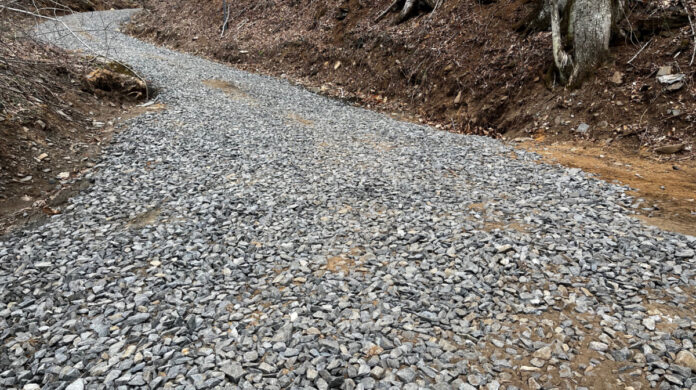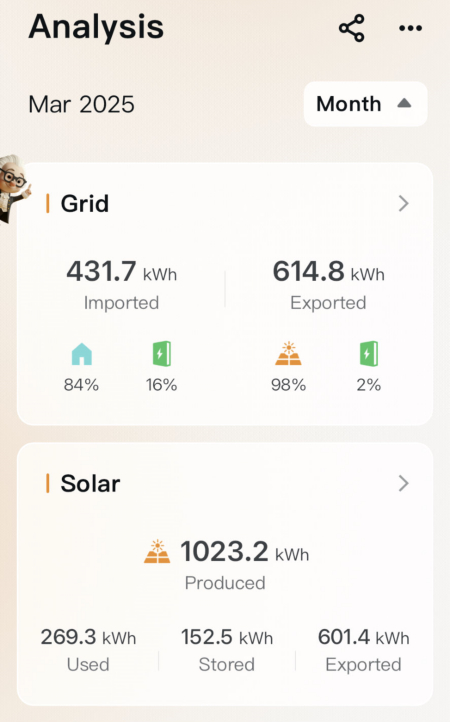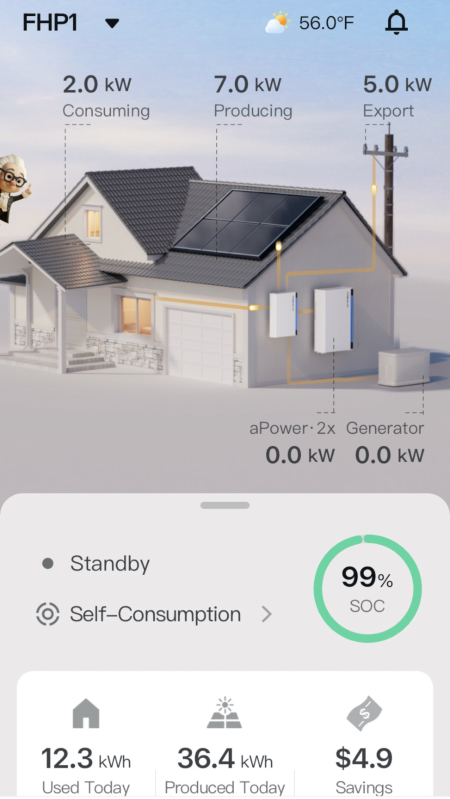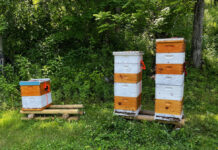
As you can see in the above image, our private road just got two loads of ballast delivered and spread over the muddy areas at the bottom where the road turned into a river during Helene. We are excited to see the contractor is starting work on repairs and rebuilding, including replacing culverts and improving ditches.
Solar Power Shines in March
We won’t get our utility bill for at least ten days, but we expect good news. During March, we imported about 432 kilowatt hours (kWh) from our utility and exported more than 600. That means they owe us for 180 kWh.

Our solar power system produced more than 1,000 kWh, or one megawatt hour. We used 269 kWh in solar power while the sun was shining, stored 152.5 in our batteries for later use and exported 601 kWh to our utility provider. This kind of surplus production was made possible because there were many sunny days and very few cloudy or rainy ones. It was quite the opposite from January when it seemed to be cloudy, snowy, or raining most days.
In March, we consumed more than 750 kWh, with 360 coming from the panels. Our lower-than-average consumption is because we rarely used our HVAC, relying on wood fires when the temperature dropped. We didn’t use much power from the batteries because the threat of power outages was so high, we often kept the batteries 90 percent charged so we would have plenty of “spare” power on hand to see us through the outages.
Frequent Power Outages
That was a good precaution because we had ten power outages in March. The longest was 8 hours and 37 minutes. The next longest was almost three hours. Most were less than one hour and a few were as short as five minutes. Some were weather related, but many were for unknown reasons.
It has been very windy up here. Less than 20 miles away, a tree knocked down a power line, which started a fire and caused an outage. That’s an outage and a wildfire warning all rolled into one.
While the sunny weather is good for producing power, we could use some more rain to minimize the threat of fires. I have the second IBC tote cleaned, set up and functioning, but there is so much downed and dry wood in the forest I am hoping we never need to use it.
March through May

I expect March through May to be good months for solar because we won’t be using the air conditioning, which is our largest power draw. With any luck, we won’t need it much in June, either. This year, January was our largest bill at $71. If we can keep our total power bill under $200 for the year, which seems likely, we will save 90 percent of annual bill, or $1800 in savings. That will help offset the cost of the system.
In a long-term grid-down scenario, we should be able to manage well during these sunny months, and throughout the summer. We will need to be careful about when we run certain large appliances, but as long as it is sunny, we can use the dryer or the oven, just not both at once.
One habit we have changed is to run the dishwasher during the day, usually after our noon meal. My wife used to run it at night, but that drains the batteries. When we run it in the day, we are using our solar power instead of selling it back to the utility.
Water Problems
One of our part-time neighbors came up this weekend to de-winterize his house. He found his water tank was empty. I helped him open his cistern, and we found there was no water flowing into it. Our best guess is that some of the trees that uprooted during Helene severed the pipes that bring water from his spring to his cistern. (This happened multiple times in our county, not only with springs but with wells and even city water.) Of course, it is also possible that the pipe froze and split and is now leaking water. As you may recall, our pipes froze again this year.
He didn’t build the house, so he does not know where his spring is. His plan is to call the plumber.
Someone will have to hike up and down the mountain, clamoring over and around downed trees, looking for a piece of broken pipe jutting out of the ground or a root ball. We don’t even know if it is black PE pipe, white PVC pipe, or something else. The house is at least 30 years old.
We offered him some of our bottled water, our 5-gallon jugs of water, and to fill up from our spigot whenever he needed to. He’s only up here three or four days, so he’ll be OK. But he won’t bring his family up to visit until he fixes it.
Prepping at Your Retreat
Our water has gone out at least four times in the five years we have lived here, but I’ve been able to fix it in all but the most recent one when we just waited for it to thaw. After the first one, I learned to keep extra pipe fittings, 100 feet of pipe, hose clamps and an assortment of tools on hand, just in case.
Our first water outage occurred less than a month after we moved in. This is an example of why it is a good idea to live at your retreat or at least visit frequently and in all kinds of weather. That way, you can tackle problems like a water outage when it is a fixable problem rather than after the SHTF when there are no outside resources available.






